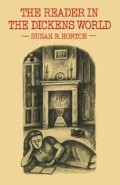Abstract
Most of the action in David Copperfield takes place in carefully circumscribed locales: around the hearthside at Blunderstone, at the Peggottys’ cosy houseboat, at Betsey Trotwood’s cottage, or at the Wickfields’ home. But for brief spaces of time, while David makes his way to Betsey Trotwood’s after running away from his job at Murdstone and Grinby’s, the reader encounters quite another and a different world. David tries to pawn his jacket to get money to buy some bread, and in doing so he finds himself having to contend with a strange old man ‘with … trembling hands, which were like the claw of a great bird’, who shrieks at him, grabs him by the hair, and repeats, ‘Oh, my eyes and limbs, what do you want? Oh, goroo, goroo!’ [DC.xiii.184]. David extricates himself from this strange man after much time and difficulty, runs down the highway, only to encounter a young tinker who interrupts his beating of his wife just long enough to steal David’s scarf from around his neck, and then resume knocking her about again [DC.xiii.187–8].
About suffering they were never wrong, The Old Masters; how well they understood Its human position; how it takes place While someone else is eating or opening a window or just walking dully along.1
‘But,’ says Mrs Harris, the tears a-fillin in her eyes, ‘you knows much better er than me, with your experienge, how little puts us out. A Punch’s show, a chimbley sweep, a newfundlandog, or a drunkin man a-comin round the corner sharp, may do it.’2
Access this chapter
Tax calculation will be finalised at checkout
Purchases are for personal use only
Preview
Unable to display preview. Download preview PDF.
The World Beyond the Dickens World
Nikolai Gogol, Dead Souls, tr. Andrew R. MacAndrew (New York: New American Library, 1961) p. 20.
Kenneth Burke, A Rhetoric of Motives (Berkeley: University of California Press, 1969) p. 115.
Sylvia Bank Manning, Dickens as Satirist (New Haven and London: Yale University Press, 1971) p. 168.
Leo Marx, The Machine in the Garden (London: Oxford University Press, 1964) pp. 19, 32.
Alexander Welsh, The City in Dickens (Oxford: Clarendon Press, 1971) p. 162.
Wayne Booth, The Rhetoric of Fiction (Chicago: University of Chicago Press, 1961) p. 136.
Barbara Hardy, The Moral Art of Charles Dickens (London: Athlone Press, 1970) p. 11.
H. M. Daleski, Dickens and the Art of Analogy (New York: Shocken Books, 1970).
See John Butt and Kathleen Tillotson, Dickens at Work (London: Methuen & Co., 1957) pp. 33–4, for a more detailed account of these note pages and their probable function.
George Orwell, ‘Charles Dickens’, in The Collected Essays, Journalism, and Letters of George Orwell, eds. Sonia Orwell and Ian Angus (New York: Harcourt, Brace & World, 1968) I, 417.
E. M. Forster, Aspects of the Novel (New York: Harcourt, Brace & World, 1927.) p. 95.
Simon Lesser, Fiction and the Unconscious (Boston: Beacon Press, 1957) p. 185.
Yrjo Hirn, ‘Art the Reliever’, in A Modern Book Of Aesthetics, ed. Melvin M. Rader (New York: Holt, 1935) p. 110.
Norman N. Holland, The Dynamics of Literary Response (New York: Oxford University Press, 1968) pp. 164–5.
Geoffrey Hartman, The Fate of Reading (Chicago: University of Chicago Press, 1975) p. 209.
H. A. Taine, History of English Literature, trans. H. Van Laun (New York: John Wurtele Lovell, 1873) p. 591
William J. Harvey, Character and the Novel (Ithaca, N.Y.: Cornell University Press, 1965) p. 142.
Thomas Carlyle, ‘The Present Time’, in Latter Day Pamphlets, in the Centenary Edition of Carlyle’s Works, ed. H. D. Traill, 30 vols (New York: 1896–1901); (rpt in 1 vol., New York: A.M.S. Press, 1969) p. 15.
Joseph Wood Krutch, Experience and Art (New York: Smith & Haas, 1932) pp. 63–4.
Taylor Stoehr, Dickens: The Dreamer’s Stance (Ithaca, N.Y.: Cornell University Press, 1965).
Author information
Authors and Affiliations
Copyright information
© 1981 Susan R. Horton
About this chapter
Cite this chapter
Horton, S.R. (1981). The World beyond the Dickens World. In: The Reader in the Dickens World. Palgrave Macmillan, London. https://doi.org/10.1007/978-1-349-05063-5_5
Download citation
DOI: https://doi.org/10.1007/978-1-349-05063-5_5
Publisher Name: Palgrave Macmillan, London
Print ISBN: 978-1-349-05065-9
Online ISBN: 978-1-349-05063-5
eBook Packages: Palgrave Literature & Performing Arts CollectionLiterature, Cultural and Media Studies (R0)

